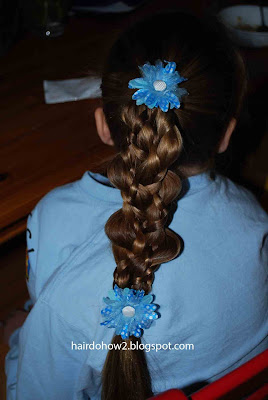This braid looks like very difficult weaving, but it's really not so difficult. Begin with a ponytail. Divide the tail into three equal sections. For each section you will make an wavy braid by taking two tiny sections and braiding them with one large section, and then tugging gently at the edges of the large sections to make them flair out a bit.
Make three of those braids, and then braid them all together.
Add bows or bows or flowers to accessorize. (Ours are from Gimme Clips.)





wow...very pretty hair style.
ReplyDeleteIf anyone have the problem of hair loss then they can get the PRP therapy in Kakinada at very affordable prices.
C++ Coaching Classes
ReplyDeleteWhen writing an article about C++ programming language, you have a variety of topics to choose from. Here are some ideas for the content of an article on C++ programming:
Introduction to C++: Provide an overview of C++ programming language, its history, and its key features. Explain why C++ is widely used in various domains and highlight its advantages.
Basics of C++ Syntax: Discuss the basic syntax and structure of C++ programs. Cover topics such as variables, data types, operators, control structures (if-else, loops), and functions.
Object-Oriented Programming in C++: Explain the principles of object-oriented programming (OOP) in C++. Discuss classes, objects, inheritance, polymorphism, and encapsulation. Provide examples to illustrate the concepts.
Memory Management in C++: Dive into memory management in C++. Discuss stack and heap memory, automatic and dynamic memory allocation, and the usage of pointers. Explain the importance of proper memory management and techniques for avoiding memory leaks.
Standard Template Library (STL): Explore the features and functionalities of the Standard Template Library in C++. Discuss the various containers (such as vectors, lists, and maps) and algorithms provided by the STL. Provide examples of using STL components in real-world scenarios.
Exception Handling in C++: Explain how exception handling works in C++. Discuss the try-catch block, throwing and catching exceptions, and creating custom exception classes. Illustrate the importance of proper exception handling in writing robust and error-tolerant code.
Looking for a natural solution for erectile dysfunction? Labub Kabir Qadeem Capsule, crafted by Al Qadeem Dawakhana, is a trusted Ayurvedic formulation designed to enhance vitality and performance. Discover more about this powerful remedy here: Ayurvedic Medicine for Erectile Dysfunction.
ReplyDeleteVery Good And Useful information Thank For Sharing if you want to visit - Ayurvedic medicine for ED visit Al Qadeem Dawakhana.